The ancient metropolis of Babylon kicks off an epic new series of silver coins called ‘Lost Civilisations’
Regulars will know that we’ve always had a soft spot in the sea of coins featuring the ancient myths and legends of old, for coins that look at the real history of the period. The Mint of Poland had a neat series back when AgAuNEWS was taking its first steps, one that became quite a hit on the secondary market, and which looked at the architecture of ancient cultures. It debuted in 2014 with one showcasing the monuments of the Mesopotamian civilisations that grew up in the region around the Euphrates and Tigris rivers.
Fast forward to today, and Numiscollect have launched the first in their ‘Lost Civilisations’ series, looking at the same Mesopotamian culture – more specifically, Babylonia. However, this new issue is a perfect example in just how far minting techniques have come in the last half-decade. Despite sharing the rimless, 2oz silver format with antique finishing, what Numiscollect have done is on a whole other level.
The reverse face is filled with looks at the architectural wonders of the city of Babylon. There’s a ziggurat, the famous Hanging Gardens, and the gorgeous blue and gold polychrome-glazed brick wall design that adorned, amongst other things, the amazing Ishtar Gate from the Neo-Babylonian empire, headed by Nebuchadnezzar. It’s not often we see bright colour on designs like this, but knowing the gate and the culture, (if you’re ever in Berlin, go see it) it’s totally appropriate here and works perfectly.
The coin obverse is quite unusual. Employing the latest iteration of the CIT/BHM proprietary Smartminting technology, we get to see some very impressive high relief detail on both sides of the coin, but the obverse of this piece is just sublime in execution, trumping even the reverse face for design and execution. The level of relief is extreme for a two-ounce coin that had one face like it, but this has two! It’s a stunning piece of coin art, replete with detail, perfect anatomy (both warrior and mount). Even the inscriptions are placed as sympathetically as possible, something that irks here if not done well.
Now, I’m the first to admit to a bit of bias for the subject matter here, just as I have for prehistoric life on a coin, but even taking that into account, I’ve got this down as one of my best coins of the year, There’s a level of care that’s gone into each element of the design, from the Lamassu and the people on the reverse, to the perfect sense of scale and perspective on the obverse. If we gave an award for ‘Obverse of the year’, this would take it.
Available to order now, the coin has a mintage of 555 pieces and will come boxed with a Certificate of Authenticity. It should ship in early Q2/2021 (March-ish), as long as Coroney keeps its head down. A terrific first release in a series we will definitely be keeping an eye on here.
MINTS DESCRIPTION
The first issue in the “Lost Civilization” series is Babylon. Using the reloaded Smartminting making the impossible possible this coin brings back civilizations to life. Obverse with detailed skyline of Babylon with its unique blue tiled painted walls and reverse with a Babylonian horsemen. Minted in the best antiqued quality on a 2oz pure silver 45mm blank. Two side ultra high relief. Just 555 pcs are released worldwide!
Babylon was the capital city of Babylonia, a kingdom in ancient Mesopotamia, between the 18th and 6th centuries BC. It was built along both banks of the Euphrates river, with steep embankments to contain the river’s seasonal floods. The town became part of a small independent city-state with the rise of the First Babylonian dynasty in the 19th century BC.
The Amorite king Hammurabi created a short-lived empire in the 18th century BC. He built Babylon into a major city and declared himself its king. Southern Mesopotamia became known as Babylonia and Babylon eclipsed Nippur as its holy city. The empire waned under Hammurabi’s son Samsu-iluna and Babylon spent long periods under Assyrian, Kassite and Elamite domination. After being destroyed and then rebuilt by the Assyrians, Babylon became the capital of the short-lived Neo-Babylonian Empire from 609 to 539 BC.
The Hanging Gardens of Babylon were one of the Seven Wonders of the Ancient World. After the fall of the Neo-Babylonian Empire, the city came under the rule of the Achaemenid, Seleucid, Parthian, Roman, and Sassanid empires.
| SPECIFICATION | |
| DENOMINATION | $10 Palau |
| COMPOSITION | 0.999 silver |
| WEIGHT | 62.2 grams |
| DIMENSIONS | 45.0 mm |
| FINISH | Antique |
| MODIFICATIONS | Smartminted ultra high-relief, colour |
| MINTAGE | 555 |
| BOX / C.O.A. | Yes / Yes |








WOW!!!! This is Amazing. I just move Smartminting and even more on two sides. A design thats one of the best I have seen!!!
It is another impressive coin. If it had come out at another time of the year, I would surely have bought it, but …….. it came out on the same day as two other spectacular coins, from the same mint. Then and Now and Clockworld Evolution. With an effort to be surprise releases I can buy two of them, but unfortunately this one I will discard because I do not have enough money.
These last months of the year there have been great launches and not only from Mayer Mint. It would have been a very incredible year for those of us who collect coins ……… if not for the damn Coronavirus.